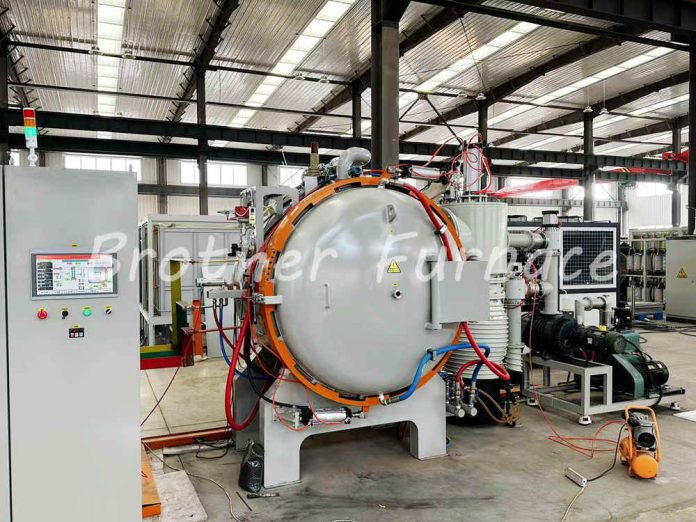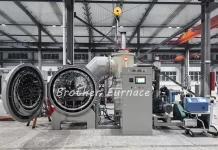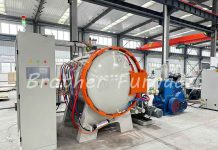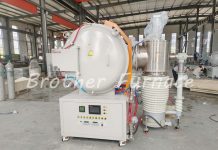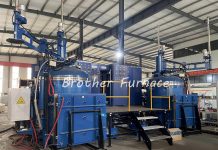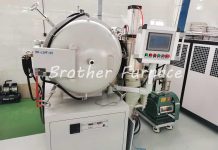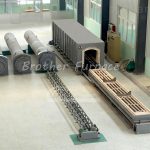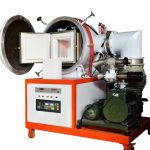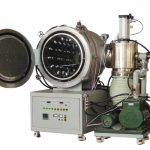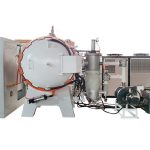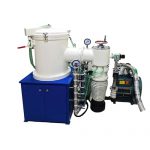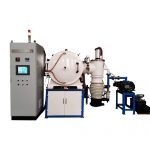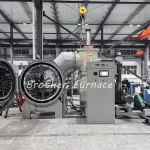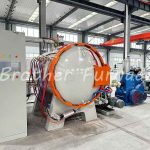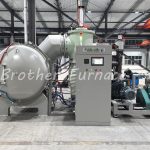In the demanding realm of high-temperature vacuum processing, furnaces utilizing graphite for both the heating elements and the hot zone construction stand out for their exceptional thermal capabilities, particularly for sintering and specialized quenching applications. Graphite’s unique properties – extremely high sublimation temperature, excellent thermal conductivity, high strength at elevated temperatures, good thermal shock resistance, and its ability to create near-ideal blackbody radiation conditions – make it indispensable for processes exceeding the practical limits of metallic hot zones. This article details the two primary applications of graphite vacuum furnaces: high-temperature sintering and vacuum quenching.
Graphite Vacuum Sintering Furnaces: Advanced High-Temp Sintering
Graphite vacuum sintering furnaces are engineered to achieve the ultra-high temperatures required for consolidating advanced materials under controlled atmospheres. Key characteristics include:
1. Graphite Heating Elements & Hot Zone
Utilizing high-purity graphite tubes as heating elements and constructing the entire working chamber (often cylindrical and vertical, though horizontal designs exist) from graphite. This ensures maximum temperature capability and uniform heating.
2. High-Temperature Prowess
Capable of reaching maximum temperatures of 2200°C, far exceeding typical metal hot zone limits.
3. Optimized Thermal Performance
The graphite construction offers low density, reduced mass, and modest thermal capacity, enabling rapid heating and cooling rates, significantly shortening overall process cycles.
4. Black Body Conditions
The graphite chamber creates highly efficient radiant heating conditions, ensuring excellent temperature uniformity within the workload.
5. Atmosphere Flexibility
Operates effectively under high vacuum or inert protective gas atmospheres (Nitrogen, Argon). Crucially, operation in oxygen-containing atmospheres is strictly prohibited due to graphite oxidation.
6. Applications
These furnaces are vital for processing materials demanding the highest temperatures and controlled environments:
- Sintering of advanced metal powders (e.g., refractory metals, carbides)
- Sintering of non-metal materials (e.g., ceramics, technical ceramics)
- Purification and sintering of optical materials
- High-temperature heat treatment of sensitive components
7. Features & Control
- Double-walled, water-cooled stainless steel/carbon steel furnace shell for safety and thermal management.
- Observation port for visual monitoring of the heating process.
- Advanced temperature measurement using W-Re thermocouples (capable of high temperatures) and infrared pyrometers, with thermocouples often featuring automatic insertion/retraction.
- Precise process control via PLC or PID auto-control systems.
See the details of our Graphite Vacuum Sintering Furnace
Graphite Vacuum Quenching Furnaces: Precision High-Temp Hardening
For applications requiring rapid quenching after high-temperature heating under vacuum, particularly for tool steels and alloys where gas quenching intensity might be insufficient or where oil is the preferred medium, graphite vacuum oil quenching furnaces offer a specialized solution. These systems feature:
1. Graphite Hot Zone
Heating elements (typically graphite tubes) and insulation (graphite felt) within a graphite chamber, enabling high-temperature heating (often suitable for temperatures exceeding 1000°C for quenching processes).
2. Dual-Chamber Design
A critical feature separating heating and quenching:
3. Rear Chamber
Dedicated to vacuum heating using the graphite elements.
4. Front Chamber
Houses the quenching media – typically incorporating both oil quenching (lower section) and sometimes gas quenching (upper section) capabilities.
5. Integrated Oil Quenching System:
Lifting Mechanism: A robust elevator system (often screw-and-nut driven by a three-speed gear motor) transfers the hot workload rapidly from the heating chamber into the oil quench tank. Speeds are optimized for smooth transfer (“low speed start”), rapid immersion (“high speed oil quenching”), and precise positioning (“low speed location”).
Oil Mixing/Circulation System: Driven by a reducer, this system features deflectors to promote turbulent oil flow around the workload, significantly enhancing heat extraction (oil cooling capacity). Designed for low noise and high efficiency.
Oil Heating System: Maintains the quench oil at a pre-set optimal temperature for consistent quenching results.
Gas Quenching Option (if equipped): An upper section for high-pressure gas quenching, sealed effectively (e.g., using staggered teeth flange structures for positive/negative pressure sealing).
6. Applications
Primarily used for bright hardening and annealing of various high-performance steels requiring rapid quenching after vacuum heating:
- Alloy steel, Tool steel, Die steelHigh-Speed Steel (HSS)
- Bearing steel, Spring steel
- Stainless steel
- Also used for vacuum sintering of ceramics, hard alloys (cemented carbides), and metal brazing.
7. Advantages of Quenching Design:
- High Quenching Intensity: Oil provides significantly higher heat extraction rates than gas, essential for hardening large sections or certain steel grades.
- Bright Surfaces: Quenching under vacuum or immediately after vacuum heating prevents oxidation, resulting in clean, bright surfaces requiring minimal post-processing.
- Proven Technology: Well-established for critical tool and die applications.
- Dual Media Flexibility: The combination with gas quenching offers process versatility.
See the details of our Graphite Vacuum Quenching Furnace
Conclusion
Graphite vacuum furnaces, defined by their graphite heating elements and hot zone construction, are essential tools for the most thermally demanding vacuum processes.
As Vacuum Sintering Furnaces, they unlock ultra-high temperatures up to 2200°C, enabling the processing of advanced metals, ceramics, and optical materials with excellent uniformity and rapid thermal cycling in vacuum or protective gas.
As Vacuum Quenching Furnaces, they provide the critical combination of high-temperature vacuum heating and rapid, intensive oil quenching necessary for achieving the required hardness and metallurgical properties in large or demanding tool and die steel components, while maintaining surface brightness.
The inherent high-temperature capability, thermal efficiency, and versatility of graphite make these furnaces indispensable for pushing the boundaries of materials processing in high-end industrial and research settings, always respecting the crucial limitation of excluding oxygen from their operating environment.
Contact us now for a custom quote or free consultation.
Graphite Vacuum Furnace for sintering Standard Model:
| Model | Heating Zone(Dia.* Height) | Temperature | Power | Voltage | Vacuum |
| BR-22STV-20 | Φ80×100mm | 2200℃ | 20kW | 380V |
7×10-3Pa |
| BR-22STV-25 | Φ90×120mm | 2200℃ | 25kW | 380V | |
| BR-22STV-40 | Φ140×160mm | 2200℃ | 40kW | 380V | |
| BR-22STV-50 | Φ160×200mm | 2200℃ | 50kW | 380V | |
| BR-22STV-60 | Φ260×270mm | 2200℃ | 60kW | 380V | |
| BR-22STV-100 | Φ320×320mm | 2200℃ | 100kW | 380V |
Graphite Vacuum Furnace for Gas Quenching Standard model:
| Model | Chamber Size (W*H*D)mm | Max. Temp (℃) | Heating Elements | Capacity (KG) | Power (KW) |
Max. Vacuum (Pa) |
|---|---|---|---|---|---|---|
| BR-QCL-334G | 300*300*450 | 1350 | Graphite | 100 | 50 | 7×10-1 Pa |
| BR-QCL-446G | 400*400*600 | 1350 | Graphite | 200 | 80 | 7×10-1 Pa |
| BR-QCL-557G | 500*500*700 | 1350 | Graphite | 300 | 120 | 7×10-1 Pa |
| BR-QCL-669G | 600*600*900 | 1350 | Graphite | 500 | 150 | 7×10-1 Pa |
| BR-QCL-8812G | 800*800*1200 | 1350 | Graphite | 900 | 260 | 7×10-1 Pa |
Graphite Vacuum Furnace for Oil Quenching Standard model:
| Model | Chamber Size (W*H*D) mm | Max. Temp (°C) | Capacity (KG) | Power (KW) | Max. Vacuum (Pa) |
|---|---|---|---|---|---|
| BR-YCL-334 | 300*300*450 | 1350 | 100 | 50 | 7×10-1 Pa |
| BR-YCL-446 | 400*400*600 | 1350 | 200 | 80 | 7×10-1 Pa |
| BR-YCL-557 | 500*500*700 | 1350 | 300 | 120 | 7×10-1 Pa |
| BR-YCL-669 | 600*600*900 | 1350 | 500 | 150 | 7×10-1 Pa |
| BR-YCL-8812 | 800*800*1200 | 1350 | 900 | 260 | 7×10-1 Pa |
* Other sizes can be customized.
More Vacuum Furnaces:
- 1700℃ Vacuum Furnace
- Molybdenum Vacuum Furnace
- Vacuum Induction Melting Furnace
- Vacuum Hot Press Furnace
Follow us on Facebook

